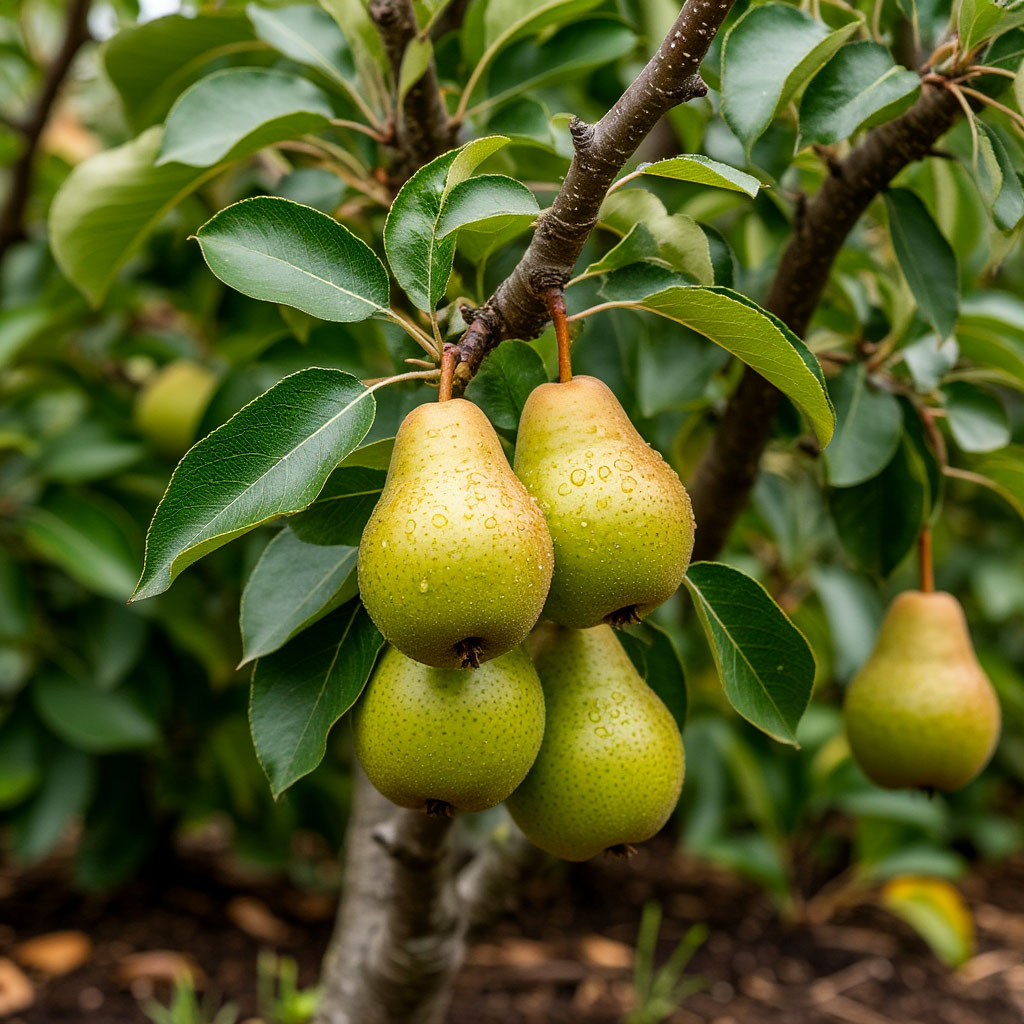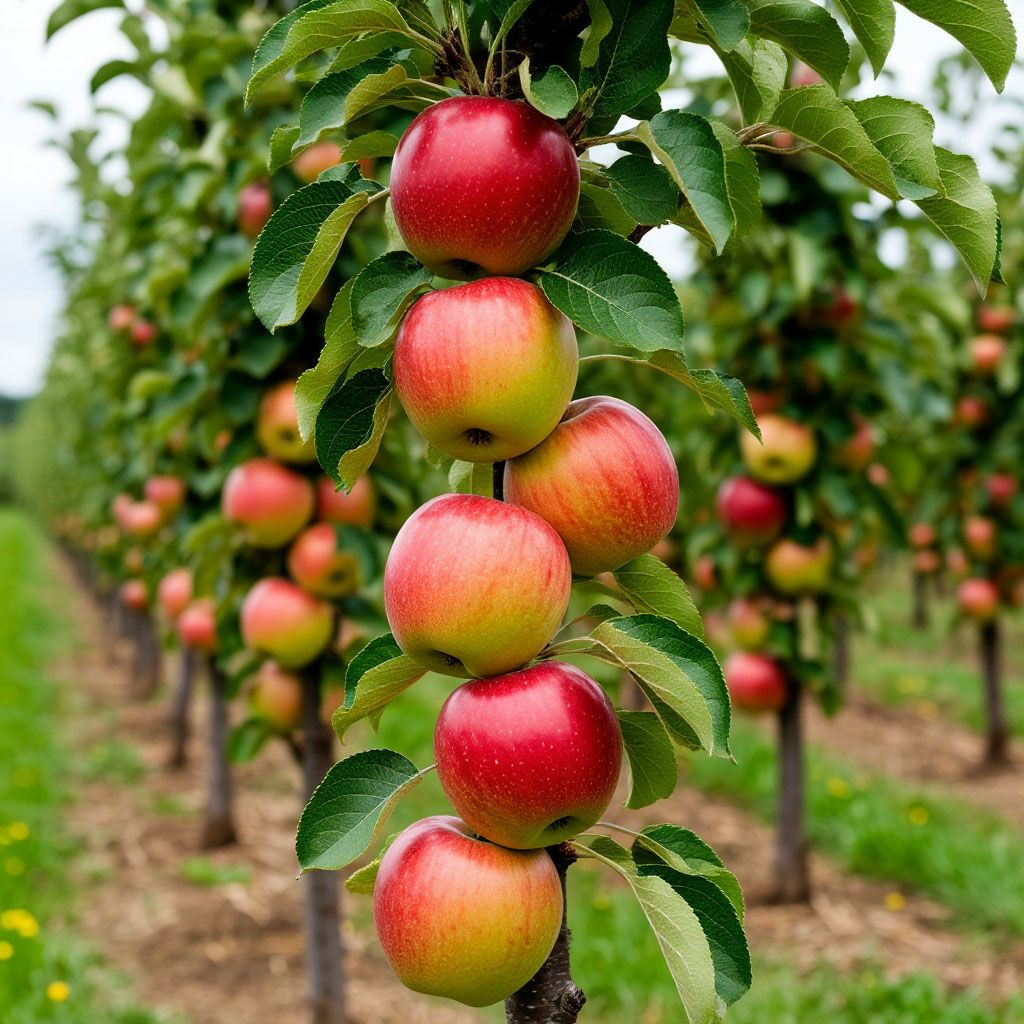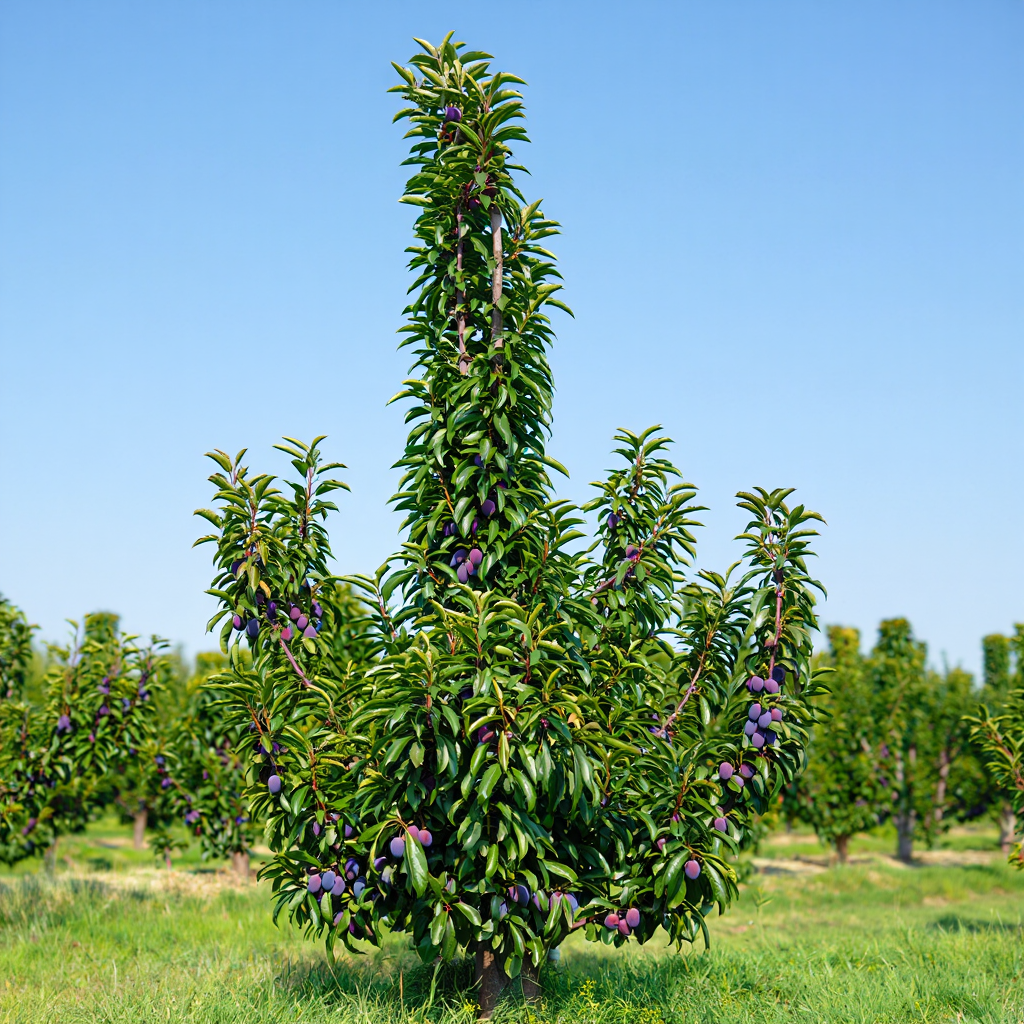Columnar pears are compact trees that are ideal for small plots. They take up little space, but at the same time give a good harvest. In this article, we will look at how to properly plant columnar pears, take care of them, choose the best varieties and protect them from diseases.
At the end you can download a brochure in which you’ll find a decision checklist, compact planting and container specs, training and pruning for a slender column, watering and feeding basics, a seasonal calendar, and a small planning worksheet.
Columnar pears: landing

Planting a columnar pear requires careful preparation, because the further growth and fruiting of the tree depends on it. These compact trees, unlike ordinary pears, have a poorly developed root system, so they are especially sensitive to soil composition, humidity and location.
Choosing a location is the first and most important step. Columnar pears like sunny, well-warmed areas protected from strong winds. If you plant the tree in the shade, the fruit will be smaller and less sweet. It is important to avoid lowlands where cold air accumulates and water stagnates – this can lead to root rot.
Pear prefers loose, fertile soil with a neutral or slightly acidic reaction. If the soil is clayey and heavy, it should be loosened with sand and compost. In the sandy soil, on the contrary, clay and humus are added to retain moisture. 2-3 weeks before planting, it is recommended to dig up the site and apply organic fertilizers (rotted manure, compost).
The landing pit is prepared with a depth and width of about 50-60 cm. Drainage (expanded clay, broken bricks) is laid on the bottom, especially if the ground water lies close to the surface. Then a nutrient mixture is added: 2-3 buckets of humus, 100 g of superphosphate, 50 g of potassium salt and 1-2 cups of wood ash. Fertilizers are mixed with the ground to avoid burning the roots.
Planting the seedling is done carefully, so as not to damage the roots. The tree is placed in the pit, spreading the roots, and covered with earth, slightly tamping. The root neck should remain at the level of the soil – deepening leads to slow growth, and too high planting leads to drying out of the roots. After planting, the pear is watered abundantly (2-3 buckets of water) and mulched with peat, sawdust or straw to preserve moisture.
The distance between the trees should be at least 50 cm, and between the rows – 1-1.5 m. This will provide sufficient lighting and ventilation for the prevention of diseases.
If planting is done in autumn, young trees should be insulated before winter: wrap the trunk with burlap or agrofibre, and cover the trunk circle with a thick layer of organic matter. Spring planting is preferable in regions with harsh winters, as the seedling will have more time to root before the cold weather.
Proper planting of a columnar pear is the basis for its healthy growth and abundant fruiting. If everything is done correctly, in 2-3 years the tree will begin to delight with delicious and juicy fruits.
Care for columnar pears

Columnar pears require special care, as their compact shape and underdeveloped root system make them more vulnerable than ordinary fruit trees. Proper care of columnar pears includes several key aspects: watering, fertilizing, pest control, and preparing for winter.
Watering system
Columnar pears need regular hydration, especially in the first years after planting. Their roots are located close to the surface, so drying out the soil quickly affects the condition of the tree.
- Watering frequency:
- In hot weather-2-3 times a week (10-15 liters of water per tree).
- In cool weather – 1 time in 7-10 days.
- Irrigation methods:
- It is better to use drip irrigation or irrigation in the trunk circle.
- After moistening, the soil is mulched (peat, sawdust, straw) to preserve moisture.
It is important to avoid stagnation of water – this can lead to diseases of columnar pears, for example, root rot.
Top dressing
Due to the small volume of the root system, columnar pears quickly consume nutrients, so they require regular fertilizing.
- In spring (before budding):
- Nitrogen fertilizers (urea, ammonium nitrate – 30 g per 10 liters of water).
- Organic matter (rotted manure, compost – 5 kg per tree).
- In summer (during the fruiting season):
- Potash-phosphorus mixtures (superphosphate, potassium sulfate – 40 g per 10 liters).
- Foliar top dressing (spraying with an ash solution – 200 g per bucket of water).
- In autumn (after harvest):
- Phosphorous-potash fertilizers (to strengthen the roots before winter).
- Avoid nitrogen-it stimulates the growth of shoots, which is dangerous before frost.
Protection from pests and diseases
Columnar pears are susceptible to the same diseases as ordinary ones, but due to the compactness of the crown, the infection spreads faster.
- Major diseases of columnar pears:
- Scab (brown spots on leaves and fruits – – treatment with Bordeaux liquid (1%).
- Powdery mildew (white coating) – spraying with Topaz or Honey.
- Fruit rot – removal of affected fruits, treatment with copper sulfate.
- Pests:
- Aphids, pear moth – insecticides (Actara, Iskra).
- Prevention: spring spraying with Carbophos.
Preparing for winter
Young columnar pears are sensitive to frost, so they require insulation:
- Mulching of the trunk circle (peat, humus, lapnik).
- Wrapping the trunk with burlap or agrofibre.
- Rodent protection (netting, repellers).
Additional recommendations
- Regularly loosen the soil around the tree (to a depth of 5-10 cm) to improve air exchange.
- Remove weeds that compete for nutrients in a timely manner.
- Monitor the condition of the crown – if necessary, prune columnar pears (remove dry and damaged branches).
Proper care of columnar pears will ensure a stable harvest and tree health for many years to come.
Best varieties of columnar pears

Columnar pears have gained popularity among gardeners due to their compact size, decorative appearance and ability to produce abundant crops in small areas. When choosing a variety, it is important to consider:
- climatic features of the region;
- maturation period;
- taste qualities of fruits.
Let’s look at the most promising varieties that have proven themselves well in different growing conditions.
Early-maturing varieties
They are ideal for regions with short summers. The variety “Decora” ripens in late July – early August. Trees of this variety reach a height of 2-2. 5 meters and are characterized by a high yield – up to 8 kg per plant. Fruits weighing 200-250 g have a juicy pulp with a light honey taste. A special feature of the variety is its resistance to scab and powdery mildew, which makes it an ideal choice for wet climates.
For lovers of large fruits, the Carmen variety is suitable, which gives pears weighing up to 300 g with an original burgundy color. The flesh has a delicate consistency and sweet taste with a slight sourness. This variety begins to bear fruit in the second year after planting and shows good winter hardiness, withstanding frosts up to -25°C. In the northern regions requires additional shelter for the winter.
Medium-ripened varieties
They are represented by a popular variety “Saphira”, maturing in September. Trees of this variety grow up to 1.8-2 meters and give a stable yield of yellow-green fruits with a red barrel. A special feature of “Saphira” is a long shelf life of fruits – up to 2 months in a cool room. The variety shows excellent adaptation to various soil conditions, but is sensitive to drought, requiring regular watering.
“Honey” is another outstanding variety, which got its name for the exceptionally sweet taste of the fruit. Pears ripen in mid-September, have a small size (150-180 g), but are characterized by an incredibly juicy pulp. Trees of this variety have high frost resistance (up to -30°C) and resistance to major diseases, which makes them an ideal choice for northern regions.
Late varieties
Among them, “Dalikor” of French selection deserves special attention. The fruit ripens in October and can be stored until January. Trees of this variety are characterized by a compact crown and high productivity – up to 10 kg per plant. Large (250-400 g) fruits with dense pulp are ideal for preservation and long-term storage. The variety requires fertile soil and regular top dressing, but it shows good resistance to diseases.
For small gardens, the Pavlovskaya variety is perfect, which is characterized by its miniature size (up to 1.5 m high) and rapid fruit production – the first fruits can be obtained the very next year after planting. Pears weighing 120-150 g ripen in August and have a pleasant sweet and sour taste. This variety is especially appreciated for its decorative appearance during flowering and fruiting.
When choosing a variety for the Moscow region and central Russia, you should pay attention to “Severyanka” – a specially bred winter-hardy variety that can withstand frosts up to -35°C. The fruits are small (100-120 g), but very fragrant, ripen in late August. Trees of this variety are practically not affected by fungal diseases and tolerate temperature changes well.
For southern regions with hot summers, the “Summer Duchess” variety is ideal, which is characterized by drought resistance and tolerance to high temperatures. Large (up to 300 g) fruits with oily pulp ripen in July-August. A special feature of the variety is self-fertilization, which allows you to get yields even with a single planting.
When choosing a variety of columnar pear, it is important to take into account not only taste preferences, but also the characteristics of the site. For heavy clay soils, it is better to choose varieties on a quince rootstock that better tolerate waterlogging. On sandy soils, varieties with increased drought resistance are preferable. A properly selected variety is the key to a plentiful harvest and longevity of the tree.
How to prune columnar trees

Pruning of columnar pears has its own characteristics that differ from the formation of ordinary fruit trees. The main goal is to maintain a compact shape, ensure good fruiting and prevent crown thickening.
Pruning in the first year
- After landing, the central conductor is not touched – it should grow up without restrictions.
- If the seedling has given side shoots, they are shortened to 2-3 buds (leave 5-7 cm).
Pruning for the second and third year
- Side branches are cut to 1/3 of the length, leaving no more than 3-4 buds.
- Vertical shoots growing parallel to the trunk are cut out completely – they thicken the crown.
- The central trunk is not pruned if it is healthy and well-developed.
Pruning an adult tree (4+ years)
- Removed annually:
- Dry, broken and diseased branches (sanitary pruning).
- Branches growing inside the crown (they interfere with lighting).
- Old unfruitful shoots (rejuvenating pruning).
- The side branches are shortened to 15-20 cm to encourage fruiting.
What should I do if the top is frozen or broken?
- If the apical bud is damaged, one strong shoot is selected below it and directed vertically, and the rest is removed.
- If the trunk splits, one leader is left, and the second is cut out.
Diseases of columnar pears
Diseases of columnar pears can reduce yields, so it is important to recognize and treat them in time.
- Scab-appears as spots on leaves and fruits. Treatment: spray with Bordeaux liquid.
- Powdery mildew is a white coating on the leaves. Treatment with fungicides.
- Fruit rot-affects pears in wet weather. Affected fruits are removed.
Prevention includes proper care, timely pruning and treatment with copper-containing preparations.
Columnar pears are an excellent choice for gardeners who want to get a harvest with minimal space consumption. Proper planting, proper care, selection of the best varieties and protection from diseases will help to grow healthy and fruit-bearing trees. Follow our recommendations and your garden will delight with delicious pears every year!
Save a copy of the brochure for quick reference — CD Columnar Pears — Mini Brochure (PDF).


